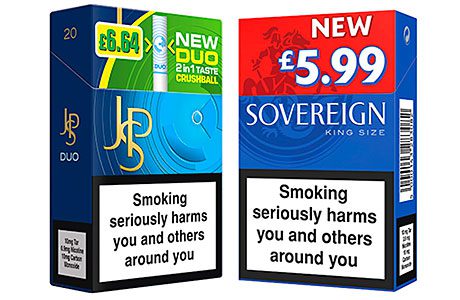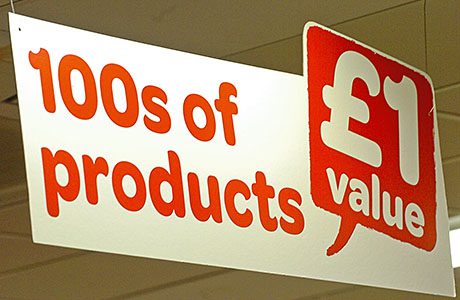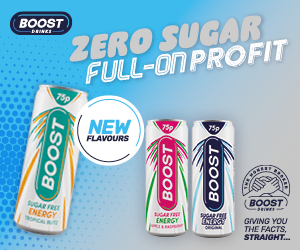How, exactly, do you feel about price-marked packs? Lines that come already marked with a prominently positioned, recommended retail price on the pack have become the rule rather than the exception in several product categories in many convenience stores.
They’re said to make consumers feel more secure about the price they are being asked to pay.
But they undoubtedly diminish the retailer’s ability to edge up prices if they wish.
We asked three retailers for their views and we’ve also been checking out some of the latest PMP marketing activity.
[hr]
PRICE-marked packs, good or bad, an imaginative response to hard times that has benefited c-stores or a necessary evil that hurts the bottom line but can’t be avoided?
For many suppliers there’s an easy answer. PMPs give consumers confidence to buy, knowing that they’re doing so at a recommended price and, therefore, are unlikely to be exploited and also unlikely to get the items cheaper at the store that’s a few minutes walk away. And that, in turn, the suppliers argue, makes PMPs very useful for local shops such as independents and symbol stores who have often (sometimes wrongly) been thought to provide poorer value than supermarkets.
However, the use of PMPs divides opinion among c-store operators. Some retailers think they are the best thing since energy drinks and would have a bold price emblazoned across just about all their stock if they could. Others dislike them intensely and think they undermine margins and actually reduce flexibility, which can make it harder rather than easier to compete with the multiples.
John McGowan, who runs three 700 sq ft Icon Stores outlets in housing estates around Aberdeen, is a huge advocate of PMPs. He feels that, by shouting out the prices from every package, they give customers the message that he can beat the big boys on price.

That being said he doesn’t quite take the view that the more PMPs the merrier.
Products that he prefers to stock and merchandise in plain (non-PMP) packs include single-serve packets of crisps, confectionery countlines and single-serve drinks. That’s where he makes up the margin he loses on price-marked grocery and chilled items, where previously achievable profit is eroded by the establishment of a published price. Retaining his control over pricing on those items is particularly important in one of his stores that has a nursery, a primary school and a secondary school in its catchment area.
“I would take all the major stuff in price-marked packs if I could get it,”he told Scottish Grocer. “If it’s there in a PMP, I buy it.”
A PMP one-litre bottle of Irn-Bru for £1 had proved very popular, he said.
“People often buy two. I tell them, there’s a two-litre bottle for £1.50, but they prefer to take two of the smaller ones. They say they like the size.”
PMP bottles of Coca Cola have also proved successful in Icon Stores’ shops.
All biscuits in the stores are price-marked. Everything in the freezers has a price on the front, as do most of the products in the stores’ chillers. When it comes to cigarettes, John sees price-marking as crucial. “I am known for having the best prices,” he explained. “People come in here and tell me that I’m cheaper than Tesco down the road.”
Not all retailers feel exactly the same about tobacco.
Some see the advantage, even the necessity, in price-marking packs of 20 or the increasing number of PMP 19s, but use non-PMPs on 10-packs to claw back some of their tobacco margin.
That’s a strategy followed by Iqbal Sadiq, who has an 1,800 sq ft Spar, complete with post office and a Subway food-to-go franchise, on Glasgow’s Maryhill Road.
But he recognises that tobacco as a category has become enormously price sensitive and that PMPs are very important to budget smokers, whom he reckons have lost all brand loyalty and who now choose by price.
PMPs, he said, reassure them that they are getting good value. “Lots of customers come in and say, give me the cheapest brand. That would never have happened five or 10 years ago.”
Back at Icon Stores John McGowan is convinced that round-pound prices remain important, that £1 is still, for many customers, a very popular price, and that the growth of pound shops has, in fact, cemented the idea in their minds that a £1 price is a clear sign of good value. His example is a large bar of Aero that used to be 130g and cost £1. To preserve the price point, the bar now weighs 110g. “Nestlé know that, if they go over that price, their sales would halve,” he said.
However £1 goods aren’t necessarily all that easy to range, merchandise and manage.
He used to have a pound bay but found it so hard to stock that he has given up, for the time being at least. One factor in his decision was that the company that used to supply his £1 toiletries no longer has what he sees as a suitable range.

“It’s too difficult to get the right products,” he said. “But I would definitely do it again. People buy stuff they never really wanted in the first place because it’s only a pound. It’s great for us.”
Although Iqbal Sadiq agrees that £1 is a magic price – “anything at £1 flies out the shop, even in Sainsbury’s,” he said – he has also abandoned his dedicated pound bay.
“It didn’t work so well,” he said.
“It looked like a cheap part of the shop.”
He also found that when he stocked a £1 dishwashing detergent beside packs of Fairy Liquid, instead of in a dedicated one-pound aisle, he actually sold more Fairy Liquid than the pound-priced alternative.
Elsewhere in the store, he sings the praises of Spar’s own two-for-£2 chilled foods and also names cereals and beans as must-stock PMPs. And while some retailers complain, in particular, about the margins on price-marked, big-brand pet foods, he is happy with Sheba at two for £1.20.
“I don’t mind the low margin if I see the uplift on sales. It’s worth it,” he said.
“These days, nothing will sell much unless it’s on a deal.”
Both John McGowan and Iqbal Sadiq reckon that price-marking is more important in less affluent areas than in better-off ones.
In the Icon store that has the most up-market catchment area of the three, John has noticed that PMPs appear to be much less of a talking point.
And Iqbal has noticed in his store, which is fairly near Glasgow city centre, that while PMPs work well on branded goods, on many other lines he finds his customers (many of whom are buying food on the go, or meals for tonight) are less price-sensitive.
But, while the Glasgow and Aberdeen retailers both balanced any misgivings about PMPs with thoughts that on many categories they do help increase volume sales and shore up consumer price confidence, there was much less enthusiasm for marked lines from one Edinburgh retailer.
In Moredun, a housing estate on the southern edge of the city, Asif Mohammed is not a fan of PMPs.
In his 1,500 sq ft unit, Fazal Convenience Store, he avoids them wherever possible.
“They restrict profit margin,” he said.
Intense competition in some product categories means he can’t avoid them on the likes of cigarettes.“I just can’t sell non-PMPs,” he said.
And he is working to develop a small £1 section containing sweets and multipacks of crisps. But otherwise he buys plain, non-price-marked products wherever possible.
It’s not always about being able to take a greater margin than a PMP would allow, sometimes it’s about having the flexibility to charge his own price, either higher or lower.
On alcohol, for example, he told Scottish Grocer that he finds the prices on PMPs are often too high for him to compete with multiple grocers in his area.
But on countline-sized confectionery items, single-serve-sized soft drinks for immediate consumption, and eat-now pack sizes of crisps and snacks PMPs are to be avoided at all costs, he reckons. As with John McGowan in Aberdeen, those lines provide a way to make a higher margin than PMP versions would allow.

But the power of the one-pound price isn’t straightforward and our retailers reckoned there are difficulties and opportunities that have to be understood and addressed. While the existence of pound stores seems to have ensured consumers look for one-pound lines, our retailers either can’t or won’t have pound zones in their own stores. The zones can be difficult to stock and can cheapen the overall look of a c-store. Spreading the products around the shop can suggest value throughout the range. And having a one-pound or discounted line next to a brand leaders can sometimes boost sales of the branded line, one retailer found.
“All my customers know the price of two litres of Frosty Jack’s. They don’t know the price of a Mars Bar,” he said.
As the economy picks up, will price marking disappear? John McGowan hopes not. “They keep people coming in to us,” he said. “They don’t just pick up one thing, they look around the fridge and see my Lurpak is the same price as Tesco. And it’s PMPs that get that message across.”
Iqbal Sadiq agrees that it’s worth taking the hit on margin to get the volume sales that PMPs bring. “If they mean I can shift more of a product, then why not? I don’t mind if I make less on each one as long as I sell more.”











